MA Primary Care Payment Models Influenced Telemedicine Usage During the Pandemic, Research Shows
Larger primary care practices in downside risk–only payment models and capitation saw the highest telemedicine utilization rates by their patients enrolled in Medicare Advantage (MA) plans.
A study published Friday in JAMA Health Forum found a significant association between the type of primary care payment model and telemedicine use during the COVID-19 pandemic for beneficiaries enrolled in Medicare Advantage (MA).
Patients used telemedicine services at the highest rates when they were in primary care groups “reimbursed under advanced value-based payment models,” according to the authors, most of whom are executives at Humana, the second-largest MA insurer in the country.
When the primary care groups were reimbursed under fee-for-service (FFS), patient telemedicine use was lower; the authors noted that those organizations had the strongest incentive to increase telemedicine use, as they were not supported with contracted value-based payments.
Early in the pandemic, virtually all in-person outpatient visits were canceled, and the revenue of practices that rely on FFS were the most impacted. In this Research Letter, the investigators looked at the effect on payment model and practice size on telemedicine use.
The study was conducted using data from Humana’s health maintenance organization plans, identifying beneficiaries continuously enrolled in these plans from January 1, 2019, to September 30, 2020. Contract data for the patients’ primary care provider (PCP) was segmented by FFS; shared savings with upside-only financial risk; shared savings with downside financial risk; or capitation.
Advanced value-based payment models were represented by the downside financial risk and capitation contracts.
Paid claims data were analyzed for audiovisual and audio-only telemedicine from January 1, 2020, to September 30, 2020, for changes in weekly rates of telemedicine utilization, stratified by primary care payment model. The link between telemedicine use and payment model were evaluated using a patient-level negative binomial regression model that adjusted for patient age, sex, race/ethnicity, Medicare eligibility criteria, comorbidity, and practice size, and included hospital referral region fixed effects.
A population of 1.1 million individuals in MA plans was included.
Compared with FFS, the marginal effects of payment model on telemedicine visits per 1000 patients were –12.9 (95% CI, –17.4 to –8.4) for shared savings with upside-only financial risk, 71.5 (95% CI, 66.9-76.1) for shared savings with downside financial risk, and 105.6 (95% CI, 96.1-115.1) for capitation (all P <.001).
The effect was largest for practices with 8 or more clinicians, which represented 11.2% of the patients in the study.
The findings suggest “that accountability for cost, quality, and disease management under value-based payment models—and the infrastructure, technology, and management systems of organizations engaging in these models—may have been a stronger catalyst for telemedicine adoption than recouping revenue from deferred in-person visits,” the authors wrote.
One limitation to the research is that it could not include other practice characteristics that may be linked with telemedicine adoption beyond payment model and size. The authors said additional research is needed to understand how to create optimal telemedicine practices as the country moves out of the pandemic and what drives adoption of telemedicine within practices.
Earlier this week, CMS announced that it would extend some Medicare telehealth coverage policies, first temporarily granted last year, until the end of 2023 while it gathers more data.
Reference
Powers BW, Drzayich Anto D, Zhao Y, et al. Association between primary care payment model and telemedicine use for Medicare Advantage enrollees during the COVID-19 pandemic. JAMA Health Forum. 2021;2(7):e211597. doi:10.1001/jamahealthforum.2021.1597

Newly Identified RTEL1 Variant Could Broaden Genetic Landscape of Familial PF
November 15th 2025A novel RTEL1 nonsense mutation was identified in a woman with multigenerational familial pulmonary fibrosis (PF), expanding the genetic spectrum of telomere-related lung disease and underscoring the importance of genetic testing in suspected inherited interstitial lung disease (ILD).
Read More
